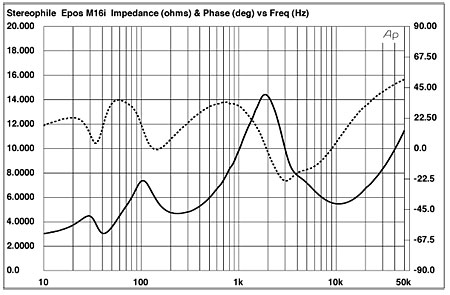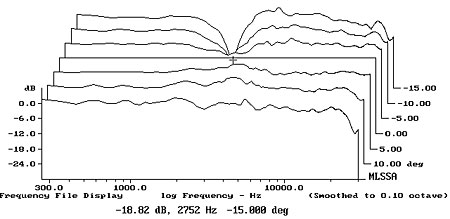| Columns Retired Columns & Blogs |
Epos M16i loudspeaker Measurements
Sidebar 3: Measurements
At 88.3dB(B)/2.83V/m, my estimate of the Epos M16i's voltage sensitivity on its tweeter axis was within experimental error of the specified figure, which is slightly above average. Its electrical impedance remained above 6 ohms throughout the upper midrange and treble (fig.1), but the use of paralleled drivers to cover the bass frequencies results in a minimum impedance of 3 ohms between 35 and 45Hz. Fortunately—and as usual—the electrical phase angle is never at its highest when the magnitude is at its lowest, so the M16i should not be too difficult a load for the partnering amplifier to drive. The shape of the impedance trace in fig.1, however, suggests that the speaker might sound a touch tilted-up in the treble when driven by a tube amplifier of highish source impedance.

Fig.1 Epos M16i, electrical impedance (solid) and phase (dashed). (2 ohms/vertical div.)
There is a very slight discontinuity in the impedance traces around 900Hz. When I investigated the M16i enclosure's vibrational behavior, I did find a strong resonant mode at that frequency on the rear panel. But to my surprise—there was no hint of its presence in the impedance traces—the strongest panel resonance lay at 633Hz, and was present on all surfaces (fig.2). As BJR didn't comment on any coloration in the midrange, it's possible that this mode is sufficiently high in frequency to be benign. (This is both because higher-frequency resonances decay more quickly than lower-frequency ones, and because the higher the frequency, the more likely it is that a high-Q resonance such as this one will "fall between the notes" of Western music and thus not be maximally excited.)

Fig.2 Epos M16i, cumulative spectral-decay plot calculated from the output of an accelerometer fastened to the center of the sidewall level with the port (MLS driving voltage to speaker, 7.55V; measurement bandwidth, 2kHz).
Turning to the M16i's acoustic behavior (measured with its grille removed), the responses of the individual drive-units are shown in fig.3. The tweeter (green trace) is a couple of dB too high in level in absolute terms, and comes in a little higher in frequency than usual, with the crossover to the midrange drive-unit set at around 3.5kHz. The acoustic slopes appear asymmetrical, with a fourth-order high-pass feed to the tweeter but a third-order low-pass rolloff for the midrange cone. This driver (black) covers a wide passband, from the upper bass through the presence region, basically 100Hz–4kHz. A single drive-unit thus handles almost all musical fundamentals. The midrange unit rolls off below 100Hz with a conventional sealed-box second-order slope, but it is in the bass region that things get interesting. The reflex-loaded woofer (blue trace) is lower in level than the midrange and broadly overlaps its output. The port, however—which is tuned to 44Hz, the frequency of the minimum-motion notch in the woofer's output—also overlaps the midrange-unit in the upper bass.

Fig.3 Epos M16i, acoustic crossover on tweeter axis at 54", corrected for microphone response, with the nearfield responses of the midrange unit (black), woofer (blue), and port (red), plotted in the ratios of their diameters below 350Hz.
The result of this unusual arrangement is that the port and woofer reinforce and extend the midrange unit's output below 100Hz, to give a combined output (fig.4, left, black trace) that offers useful low-frequency output to below 40Hz. Fig.4 reveals very little trace of the usual nearfield hump in the upper bass, suggesting that the M16i's bass will be rather overdamped, and favor clarity over weight. As BJR noted in his auditioning notes, "I've heard other speakers shake the room more when [bass guitarist Dean] Peer plunges into his axe's bottom register."

Fig.4 Epos M16i, anechoic response on listening axis at 54", averaged across 30° horizontal window and corrected for microphone response, with the complex sum of the nearfield responses plotted below 300Hz.
Fig.4 indicates that the M16i's farfield response is pretty flat overall at higher frequencies, but again with the slightly elevated top octaves and a slight swayback in the crossover region. How this balance will be perceived will depend on the speaker's horizontal radiation pattern (fig.5). The contour lines in this graph are generally smooth and even, but the midrange drive-unit can be seen to get a little more directional at the top of its passband than the tweeter. The resultant off-axis flare at the bottom of the tweeter's passband will tend to compensate for the on-axis dip, resulting in an evenly balanced treble overall. Which is what BJR found. In the vertical plane (fig.6), the M16i's dispersion indicates that the speaker must be listened to with the listener's ears no higher than the top of the cabinet; otherwise, the large suckout that develops in the crossover region above that axis will make the sound very hollow.

Fig.5 Epos M16i, lateral response family at 54", normalized to response on tweeter axis, from back to front: differences in response 90–5° off axis, reference response, differences in response 5–90° off axis.

Fig.6 Epos M16i, vertical response family at 54", normalized to response on tweeter axis, from back to front: differences in response 15–5° above axis, reference response, differences in response 5–15° below axis.
In the time domain, the Epos's step response (fig.7) indicates that all three drive-units are connected with the same positive acoustic polarity, but that the tweeter's output slightly leads that of the other two units. The decay of the tweeter's step is nicely integrated with the start of the midrange unit's step, however, correlating with the good frequency-domain integration seen in fig.4. The cumulative spectral-decay plot (fig.8) is generally clean, though with some low-level hash visible in the mid-treble, perhaps due to breakup in the midrange unit's cone.

Fig.7 Epos M16i, step response on tweeter axis at 54" (5ms time window, 30kHz bandwidth).

Fig.8 Epos M16i, cumulative spectral-decay plot on tweeter axis at 54" (0.15ms risetime).
Overall, the Epos M16i offers excellent measured performance. I can't help wondering whether the fact that what is nominally a midrange drive-unit covers such a wide range is the root cause of this speaker's excellent sound quality. Intriguing.—John Atkinson
- Log in or register to post comments




































